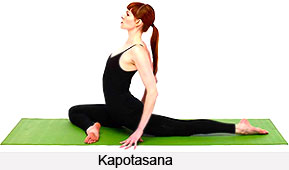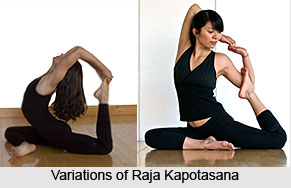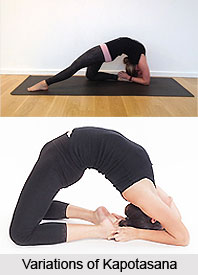 In Sanskrit, Kapota means,"pigeon," and asana means "pose." So Kapotasana, literally, means a posture mimicking a pigeon. Kapotasana means "Pigeon Pose" and the deep backbend resembles the proud thrust of a puffed pigeon chest. This is an asana that helps to open up chest and strengthen back and groin. It also involves bending backward. It gives flexibility to the Hips simultaneously strengthening the back and stretching the thighs and the groin.
In Sanskrit, Kapota means,"pigeon," and asana means "pose." So Kapotasana, literally, means a posture mimicking a pigeon. Kapotasana means "Pigeon Pose" and the deep backbend resembles the proud thrust of a puffed pigeon chest. This is an asana that helps to open up chest and strengthen back and groin. It also involves bending backward. It gives flexibility to the Hips simultaneously strengthening the back and stretching the thighs and the groin.
Although people tend to think of Kapotasana as merely a bird-shaped asana, it is actually named after a great master, Kapota, whose yogic accomplishments are documented in scriptures such as the Mahabharata and the Kalika Purana. In power, vigour, strength, vitality, and agility, Kapota had no match. When he walked, it seemed his soul was several feet ahead of his body - he moved as though not touching the ground. Thus people called him the son of Garuda, the mighty bird serving as a vehicle for Lord Vishnu.
Kapotasana is easily adapted for all levels of accomplishment. In this yoga pose, take one leg forward with a bent knee and the other leg straight behind. This is the Classic Pigeon Pose also known as "Salamba Kapotasana".
Steps of Kapotasana:
1. Begin with kneeling on the floor.
2. Stretch out the right leg behind the body.
3. Bend the left knee such that the left foot comes close to right pelvic bone with toes pointed out.
4. Lean slightly forward to puff out chest.
5. Take the support of the ground by placing the hands on it for balance.
6. Look in front and maintain a steady gaze.
7. Hold the pose for 30 secs and repeat. This is the pose for beginners.
Relax in Corpse pose if feeling exerted. The full name for this pose is "Eka Pada Raja Kapotasana", which means One Legged King Pigeon, but since that is very complex to say during practice; so it is often called Pigeon.
There is even another pose called "Raja Kapotasana" which has the front half of the body bent back like Cobra and the knees bent so that the head comes back towards the feet.
Steps of Raja Kapotasana:
1. Perform the proper Pigeon Pose as usual.
2. Bend the right leg, the extended one, from the knee such that the foot points towards the sky and hold the foot with the right hand.
3. Continuing to hold it with the right hand, draw the elbow closer to the side and draw it up as well.
4. Grip the foot with both hands and curl the head backwards.
5. Stay in the pose for 15 secs and release.
This is an excellent hip-opening and chest-opening pose. This also has the hallmark of the puffed "pigeon chest". It is an advanced pose which should not be fully attempted by beginners who may not be flexible enough.
Finally the fullest expression of the pose is a deep backbend which starts from a kneeling position and moves into a drop-back backbend. Grasp the foot from the outside edge and rotate the elbow out and up as to draw the foot toward the head. If well balanced, bring the other hand straight out in front and overhead to also grasp the foot. This version of the pose requires significant flexibility in the shoulders and upper spine, as well as in the thigh and pelvis. Repeat on the other side. Then finish with a gentle forward bend like the child"s pose to release any strain in the back.

There are several arm variations of Raja Kapotasana; a complete backbend is one which is slightly difficult to master. Though it appears to be easier than some of the other advanced poses, inversions, and backbends, the king pigeon pose requires a lot of practice before performing it with ease.
Steps of Kapotasana in Variation:
1. Be upright and kneel keeping the legs slightly apart. Keep the shoulders and head bent backwards.
2. Bring your hands behind and press at the back of your pelvis with a slight force.
3. Inhale deeply and bow your head, tucking your chin into your
sternum. Lean your shoulders back. While doing this, try and keep your hips in place.
4. Keep your shoulder blades firm and lift your chest as high as possible. Now gradually release the head and let it tilt back.
5. Bring both hands in front as the Anjali Mudra.
6. Now slowly place hands on the floor and bring the forehead to the floor as well.
7. Move the hips forward to counterbalance this move.
8. Allow the upper thighs to be perpendicular to the floor and drop back. Touch the ankles with hands and if possible, grab the heels.
9. Rest the back of the head on the soles of feet.
10. Open the front of groin as much as possible and lift the pelvis.
11. Inhale deeply. Hold the pose for about 30 seconds and keep breathing normally.
12. Exhale and expand the chest. Now release grip on the heels and slowly come back to the kneeling position.
Apart from these several variations of Kapotasana, there are two more variations namely, "Supta Kapotasana" and "Baddha Eka Pada Raja Kapotasana". These asanas are required to practice so that it can be performed with ease and help the person to get its proper benefit.
Benefit to Body Part:
•Flexes the hips, groin and thigh muscles and helps relieve back pain.
•The chest, neck and shoulders muscles are stretched which aligns body posture.
•Bounces the spine, arms, thighs, shoulders, calf muscles and hands.
•Stretches and strengthens the joints and muscles of the feet and ankles.
•Tones the muscles of the throat and body part in the chest, ribcage and abdomen.
•Liberating stiffness in the back muscle, hip and shoulder area.
•It is a good shoulder, hip and chest opener as well.
Health Benefits of Kapotasana Pose:
•Refining blood circulation in body and even increases digestive system.
•Treat blood pressure problems as well as other chronic-related diseases.
•Reduce sciatica and makes strong lungs.
•Excites the nervous system.
•Pigeon Pose in yoga treats urinary disorders.
•Alleviates lower back pain and any kind of stiffness in the back or neck.
•Stimulation of internal organs.
•The King Pigeon pose is considered ideal for women trying to conceive.
•It strengthens the lower back muscles.
Beginner"s Tips:
If one is not able to perform this pose naturally, kneel with the back to a wall and press the soles of feet to it. Now bend backwards and rest the crown of head against the wall. One may also place the hands against the wall and perform this pose as a half backbend instead of the full one. Beginners can also make use of Yoga Straps to fasten around the ball of the foot of the leg that is at the back. This will make it easier for them to catch hold of their foot.
Precautions:
Do not perform this pose if having the following conditions:
•Back injury
•Knee injury
•Ankle injury
•Neck injury
•Very tight Hips or thighs
•The exercise is not recommended for those suffering from insomnia, frequent migraines, and hypertension.
Preparatory Poses:

•Dhanurasana
•Bhujangasana
•Eka Pada Rajakapotasana
•Setu Bandha
•Virasana
•Urdhva Dhanurasana
•Supta Virasana
Follow Up Poses:
•Pasasana
•Balasana
•Adho Mukha Svanasana
•Bharadvajasana I




















